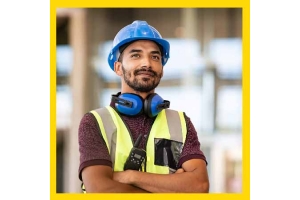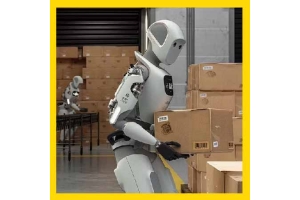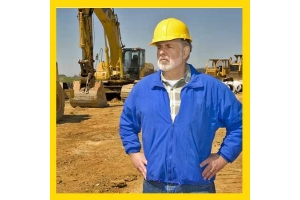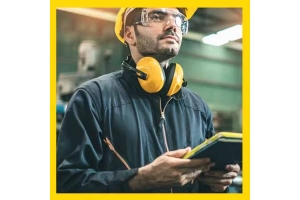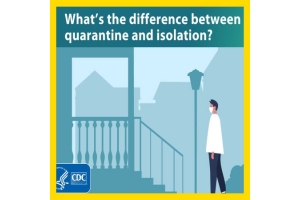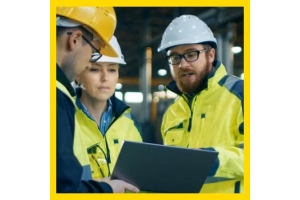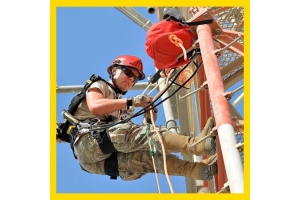Currency
-
June 29, 2019A harness is the means by which the user is safely connected to the rest of a fall protection system when working at height or near an edge where the potential for a fall exists. These systems can be thought of as a chain, with the anchor point at one end, a number of links in between, and the harness at the other end.
There are many different kinds of safety measures which may be in place to keep workers at height safe, and any system requiring Personal Protection Equipment (PPE) will require a harness of some sort to be worn by the worker.
The harness plays a vital role in preventing the user from hitting the ground if an accident were to occur, and it is the harness to which all other elements of the system such as lanyards and shock absorbers must be attached. Harness types All harnesses fulfil one basic requirement: to connect a user to a system, normally for either fall arrest, work positioning, restraint or rescue purposes. There are a number of different -
June 29, 2019One of the best things about being involved with safety is seeing the innovation that’s happening every day. Conducting arc flash testing and incident investigations, as well as working with committees such as NFPA 70E, CSA Z462, ASTM and IEC, provides insight into changes in personal protective equipment and standards that are benefiting workers. Here are some of the newest PPE and work practice changes.
Distance devices for testing electrical circuits
Many companies are making and marketing devices for proximity testing and direct testing of electrical circuits to allow workers doing troubleshooting and verification tests to stand outside the arc flash boundary. This can lower the risk of an event, incident energy and the amount of PPE needed for some common tasks.
Remote operation devices for electrical circuits
Electrical operators frequently work with circuits that have the potential to fail. Although -
June 29, 2019Choices in hand protection have grown significantly during the past 30 years.
How often do you think about your hands? Typically, our hands are an afterthought to our daily routines, especially when it comes to protecting them. But could you easily go about your daily tasks without the use or even limited use of your hands? Most of us could not, but more importantly, none of us want to find out.
According to the U.S. Bureau of Labor Statistics data for 2016, of all nonfatal occupational injuries and illnesses involving days away from work, 13 percent were for hand injuries. And 20 percent of disabling workplace injuries involve hands.
Taking a closer look at the data, we see nearly 70 percent of hand injuries occur because the worker was not wearing gloves. What does that mean for the other 30 percent? It may mean they were wearing the wrong gloves. As odd as it may seem, wearing the wrong gloves can be just as dangerous as wearing no gloves at all. Clearly, -
June 29, 2019What are some considerations that are often overlooked?
Particularly in the utility and electrical maintenance industries, using daily wear AR/FR garments can provide many safety benefits to employers and workers. By offering consistent protection in a less-cumbersome manner, which can ultimately help mitigate catastrophic burn injuries, incorporating daily wear AR/FR garments can increase the effectiveness of an organization’s safety program because it helps lessen the consequences of human error.
That said, utility workers and electricians can sometimes fall into a pattern of complacency in the wear and care of their daily wear AR/FR garments. AR/FR garments must be worn – and worn correctly – to achieve maximum protection in the event of an arc flash.
We share three common instances in which improper wear may come into play, which can help you while reviewing or -
June 22, 2019If it seems there are more questions than answers about ISO 45001, you’re not alone, but our experts provide some clarity about this new safety standard.
Every year, more than 2.78 million deaths and nearly 374 million non-fatal incidents occur globally due to occupation-related diseases or accidents. While the human cost is beyond calculation, the financial burden is enormous. The new standard developed by the International Organization of Standardization, ISO 45001, is intended to help businesses worldwide reduce this burden and create safer workplace conditions.
As a follow-up to a recent EHS Today webinar on ISO 45001 (“What is ISO 45001? And What Impact Will It Have on Your Business?”), our experts Travis W. Vance and Tom Cecich address some questions participants submitted during the webinar that couldn’t be answered within the hour.
Vance is a partner in Fisher Phillips’ Charlotte office and co-chair of the legal firm’s Workplace Safety and Catastrophe -
June 22, 2019The key ingredient when working at heights is to not start work until it is safe to do so and create a workplace where your employees feel free to speak up if they feel the right controls are not in place.
As a safety professional, how often have you observed someone working at heights who is not properly protected from a fall? Before approaching the individual, it is important to think about the conversation you are about to have to alert them of the hazard. This conversation is critical to achieve a successful outcome. More importantly, the safety culture that exists in your organization will have a huge impact on the outcome of that conversation and whether it will be received in positive or negative manner. Does your company have a culture that is receptive to both giving and receiving coaching in a respectful manner?
The statistics are a stark reminder that there is a need for change in how the industry views fall protection. Researchers from the NIOSH Fatality -
June 22, 2019Industry leaders in HSE met in Dubai for a series of talks on how digitalisation, and keeping workers connected, can bridge the safety gap for oil and gas companies. Click through gallery for the names and titles of participants
Roundtable participants
Miroslav Kafedzhiev:
VP and general manager, Middle East, Russia, Turkey, Africa, Honeywell Safety and Productivity Solutions (panel co-chairman)
Abdullatif Albitawi:
UAE branch treasurer, IIRSM
Alex George
: Corporate HSE director, China State Construction Engineering Corporation
Ephraim Ebodaghe:
HSE director, Dragon Oil
Irfan Syed:
Product marketing leader, Middle East, Russia, Turkey, Africa, Honeywell Safety and Productivity Solutions
Kaushik Roy:
Head of risk management advisory, Middle East, DNV GL
Mahmoud
-
June 22, 2019Muralikannan Navaneethakrishnan
Our voice on health and safety in the Middle East -
June 15, 2019
Food services operations where workers received free highly slip-resistant shoes showed a large reduction in workers’ compensation claims for slip injuries compared to food service operations where workers did not receive the shoes, according to research published in the Scandinavian Journal of Work, Environment & Health.
Slips, trips, and falls are the third-leading cause of U.S. non-fatal work-related injuries involving days away from work across all industries. Almost 80% of these injuries are on the same level, and these injuries are estimated to cost nearly $13 billion in direct workers’ compensation-related costs annually. Laboratory tests have shown that slip-resistant shoes designed with a special tread helped prevent slipping, but studies in actual workplaces were lacking.
To address this research gap, investigators looked at whether a no–cost-to-workers slip-resistant shoe program decreased the risk of slip injuries among food services workers. The shoes -
June 15, 2019No More guesswork
